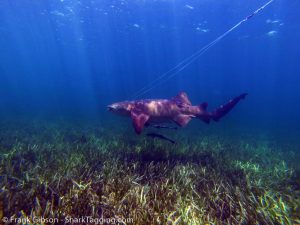By Daniela Escontrela, RJD Intern
It was another day of shark tagging and I was excited as it had been a while since I had been on the boat. Not only that but this was going to be my first trip out of West Palm Beach on Jim Abernathy’s boat. This was an unusual trip too in that our departure time was 1:30pm instead of 8:30am. We all were fresh and ready to go after being able to sleep in
Once we were at the dock, we unloaded all the gear that was in Emily’s car and moved all the drums and floats from storage on to the boat. Promptly after this, the participants from South Broward high school arrived. Our fearless trip leader, Pat, greeted them all and we all did our usual introductions to get to know each other. This was an enthusiastic group with great questions, and judging from our past success with them, I knew today would be a good day.
We all loaded onto the boat and headed out to the day’s site. We would be fishing at a shallow spot only ~20 feet deep at McArthur Park. It was about a 30 minute ride out and on the way we did our usual prep work- cutting bait, setting up drumlines to be deployed and getting everything in order. Once we got to the site we started deploying all the drumlines with the help of the students. All of them did a fantastic job of helping us and were being great sports considering the sea conditions weren’t optimal.

One of the participants helps us deploy drumlines
Once all our lines were deployed the wait began. This is always the longest part of the trip because there is so much anticipation as to whether we’ll even catch anything, and if we did what would it be. During our wait time, we talked to the students about the work up procedures we would be conducting; they listened intently and once we talked to them they each formed teams with particular jobs to do.
Once the hour soak time was done we started to pick up our lines. A couple of lines in we had caught something! It was an Atlantic sharpnose and since this species is so small we didn’t know we had anything on the line until we had pulled it up right next to the boat. Once we had this little guy secured, we put the pump in its mouth and the students diligently did their jobs getting this work up done within minutes. Soon enough we released him in great condition and he got on his way.

One of the South Broward High School participants helps in the data gathering process by taking a fin clip from the Atlantic Sharpnose
On the second set of lines we came up empty handed despite all out shark dances and positive vibes. We let our third set of lines soak an extra ten minutes to increase our odds of catching something on the last set. As we were picking up lines, halfway through the set we had another little guy! This shark was so small that we thought it was another Atlantic sharpnose or a blacknose, which also doesn’t grow big. However, as we pulled it even closer we were able to see the gorgeous stripes running down its sides and the beautiful defined spots running downs its tail. We pulled him in secured him and put a pump in its mouth. This small tiger shark came in at a mere 109 centimeters (~3.5 feet). Neither I nor anyone on our team, who at this were seasoned veterans, had never seen such a small tiger shark. These animals are amazing for so many reasons, but they are especially marvelous when they’re young because their spots and stripes are so defined. The students once again worked up this shark like experts and we gave them the chance to quickly touch it so they could understand what dermal denticles felt like. Soon enough we released this small tiger shark into the water in excellent condition. This was such a marvelous sighting! I know everyone on the boat was extremely excited because we had the rare opportunity of spotting such a small tiger shark which doesn’t happen very often.
We then proceeded to pick up the rest of our drumlines. Something strange happened on lines eight and nine though. As we were pulling up these lines we felt several tugs on the line. We thought we had something big on here. As we pulled the drum onboard and then reeled in the rest of the line however, we found that something had bitten through our 900 pound test monofilament line. This sure had to be a big animal. Then Emily made the discovery on one of the lines of a black slime, characteristic of a tiger shark.

A picture of the day’s participants, South Broward High School. Thank you for a great day of tagging!
This had been another exciting day out on the water, and the positive side of starting the trip so late is that we had a wonderful ride back into the dock with a beautiful sunset, and we were even graced with the presence of some dolphins that started to follow our boat on the way back. This had been another wonderful day out on the water and I felt extremely fortunate to have been able to see something I had never seen before. I can’t wait to get back out there and see what’s in store for us!






























